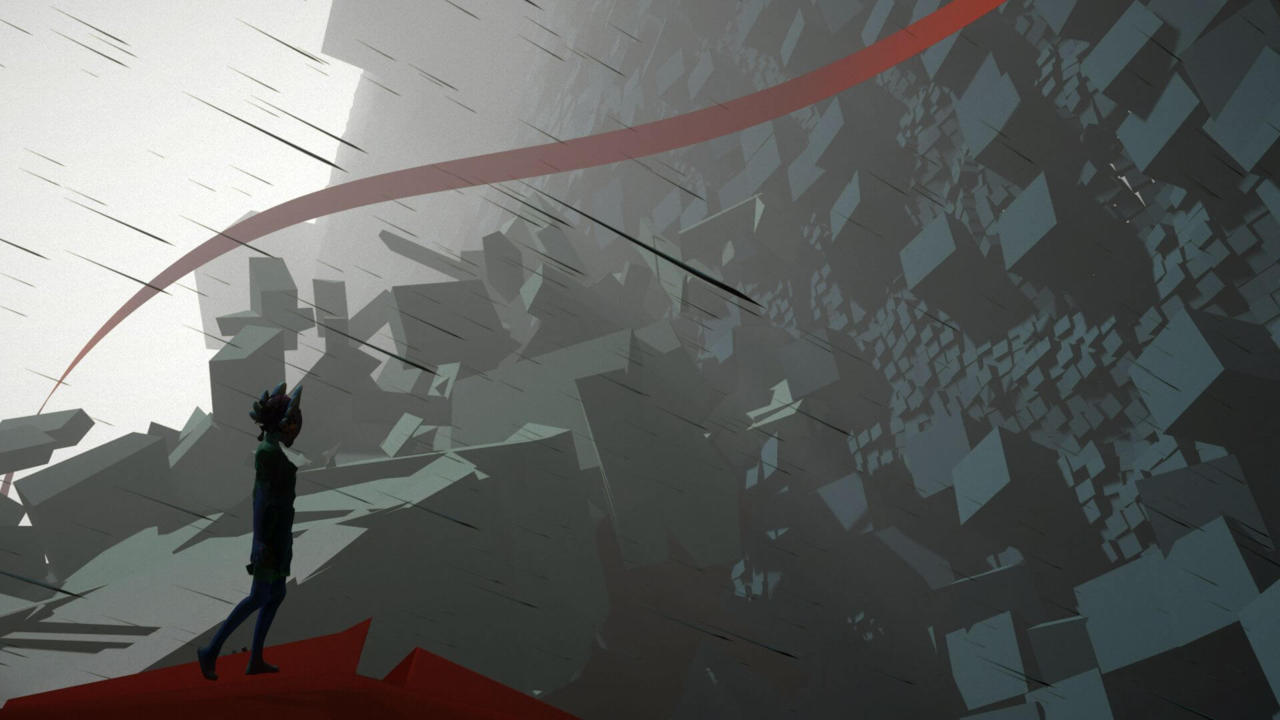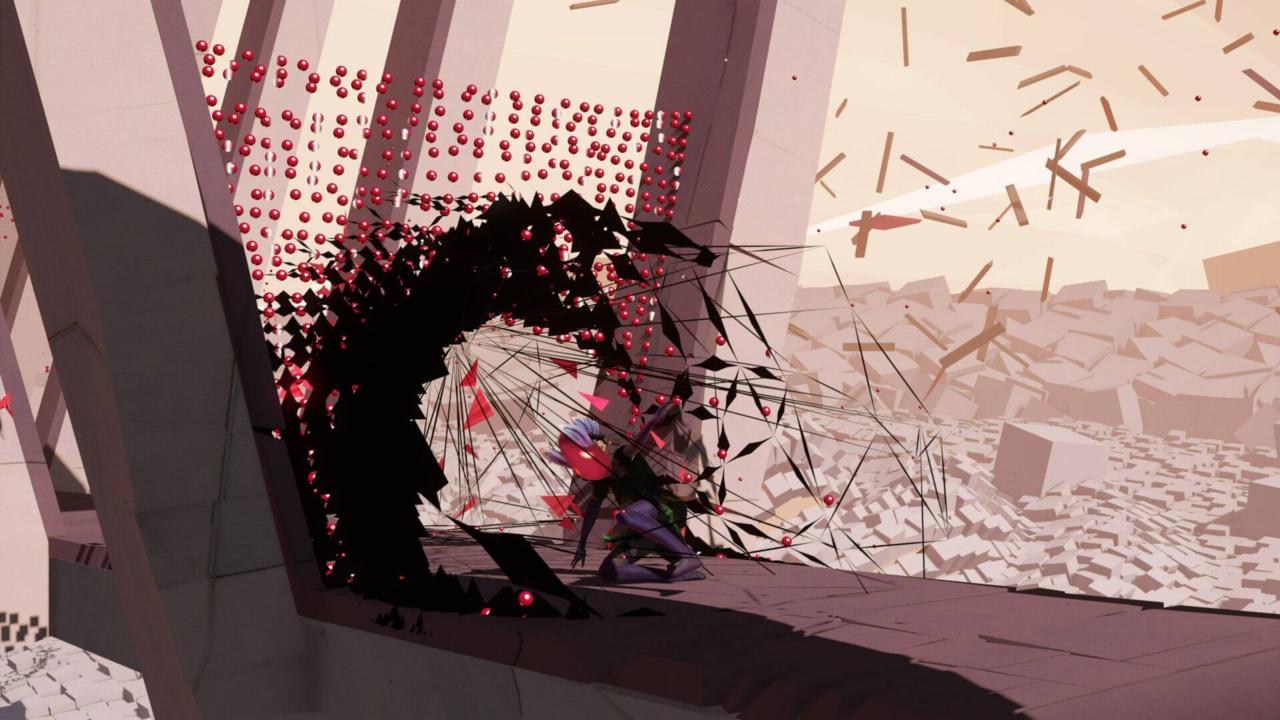Bound is dynamic. I don't mean in the way that we normally think of "dynamic" games. I mean that Bound's environments move and shift constantly. The entire world, composed of different geometric shapes, pulses and undulates. Walls fall apart and reassemble; tunnels emerge; floors fall away. Blocks and spheres appear from the ever-changing ground, thrown upward as if a giant creature living underneath is throwing a fit. Swarms of sharp-edged shapes and wiry polygonal worms wave and move, attacking if you get too close.
And visuals shift as you move through each level. The world feels like you're moving through works of abstract art. You sometimes literally walk across art pieces--during one moment, I climbed up a wall clearly evocative of a Mondrian painting, and during another, a creature emerged from a Rothko. Generally, though, the art doesn't stay still. It constantly evolves, colors shifting and fading and geometry morphing.

I was able to sit down and play this strange, unique third-person platformer with game director Michal Staniszewski, and during my demo I paused often at ledges to stare out at the disassembled levels. I felt enraptured by the vague lattices that were the only hints of familiar objects. Tornadoes of triangles and diamonds spun in the distance, and a massive monster scrambled over the deconstructed environment. It was both calming and eerie, as atmospheric music and art contrasted with the omnipresent monster and desolate setting.
It was almost hard to pull myself away from the vistas--almost. Although developer Plastic has often focused on the art since the game's announcement, it is a platformer first and foremost. But it is platforming divested of inherent difficulty and injected with the same sort of focus on art. You can't walk off edges. The main path through a level is very generous: it's pretty easy to hit jumps and the character seems to be slightly magnetized to the platforms.
In spite of its simplicity, it still felt satisfying to move through the levels. Inspired heavily by ballet, movement itself was a pleasure, as the character twirled, jumped, and danced around, . Occasionally the game forced me to search carefully through a certain room for the path, which were subtly marked with different colors. These searches let me explore the environments even more, so I discovered walls that dissolved as I moved closer, unsettling "Fears" (Plastic's name for the enemies) that would wrap around my character, and even hidden paths that opened up new ways to get through the level.
Then Staniszewski took control and showed me an entirely different side to the game. Honestly, I never really got a full picture of the other parts of Bound. Staniszewski intentionally obfuscated the more bizarre elements. However, what he did explain sounded extremely ambitious and exciting.
This is because Plastic is attempting to make Bound for three very disparate audiences. The first is fans of narrative-focused atmospheric experiences, who are targeted most obviously by the immediate emphasis on style and story. I only got a few glimpses of the narrative, but what I saw was fascinating.

During my demo, I twice walked into specific areas and triggered cutscenes. Suddenly my character was gone, and I moved around a dark room in first-person. Shards of light gathered and formed into models of people--realistically drawn people, rather than the abstract representations in the rest of the game. Objects formed around me. One cutscene solidified into a garage, with a family standing around a car. It was an abrupt and eerie change from the main part of the game, a jolt of realism in a game defined by its abstract art.
Staniszewski promised that these cutscenes will make sense in the context of the game's story, but I could not discern any link between them yet. It was so different from the platforming sections that I couldn't foresee how Plastic would bring the two together. But it was nonetheless fascinating, and a story about the merging of realism and abstraction has a lot of potential.
The developer's peculiar experiments with narrative don't end there, either. The world--the abstract part, that is--changes over the course of the game depending on the order in which you complete levels. You won't complete levels in any particular order; rather, each will require you to go back and play it again as you progress through the game. Staniszewski showed me how one level will be bright, alive, and full of enemies if you play it at the beginning of the game, but dark, rainy, and dead if played toward the end. He again refused to explain how this will play into the narrative, stating that Bound centers around players uncovering these secrets during gameplay.
This changing world also directly affects the second audience that Plastic is targeting: experienced players of platformers. Bound's platforming seemed simple and straightforward to me on my playthrough of the demo, and I completed the level with ease. But then Staniszewski took over, stepped up into the first room that I came across in my demo, and wall-jumped up to a path I didn't even know existed. He proceeded to show me a challenging and wildly different path through the level, one that was technically shorter but much more difficult than mine. And then he showed me another path, and another.

There are dozens upon dozens of ways through the levels in Bound--so many, in fact, that Staniszewski doesn't actually know of all of them. In addition, many paths only open up if you play a level later in the game, when the Fears disperse or when the game's environment is structured in a certain way. The developer has even built in a speedrunning mode into the game to encourage the speedrunning community to find the quickest path through the levels--which sounds like it'll take quite a bit of time.
The third audience that Plastic is building Bound for is that of hardcore fans of puzzle games. The way Staniszewski explained it, Bound has a meta-puzzle built on top of everything else that is involved, complicated, and meant to be completed with the help from the game's fanbase. No one at Plastic even knows what the solution to this overarching puzzle is, although Staniszewski swears that it's solvable. I didn't get a good idea of what this will look like in-game, although it seems similar to the community-solved puzzle at the end of P.T.
And if that's not enough, Bound is also coming to PlayStation VR. I tried it out, and discovered that the gorgeous art and ever-changing landscapes gained depth and immensity when experienced in VR. Fears pursued and attacked, sounding and appearing like swarms of bees, and it felt like the ever-present monster, as it reared up and roared in close proximity, was screaming directly into my face. The controls posed the only issue I had with this version: while the non-VR game has normal third-person controls, the VR version uses a fixed camera that you switch between set positions. I couldn't really get a handle on it, but it was a minor inconvenience in a VR experience that was generally smooth, comfortable, and awe-inspiring.
I've never really seen a game that looks similar to Bound, nor have I heard of one trying to pull off as many different ideas. Staniszewski acknowledged to me the monumental task of tying together all of the parts, from dynamic, modern art-inspired environments to movement that's been choreographed by ballerinas to a deep narrative to an overarching meta-puzzle. He says that Plastic's approach has been to "brute-force" these parts into working together, which is a pretty risky design philosophy.
In my demo, I certainly couldn't see how all the parts would end up working together, and yet I didn't really care. I can't even pretend to fully understand Bound yet, but I absolutely want to.

